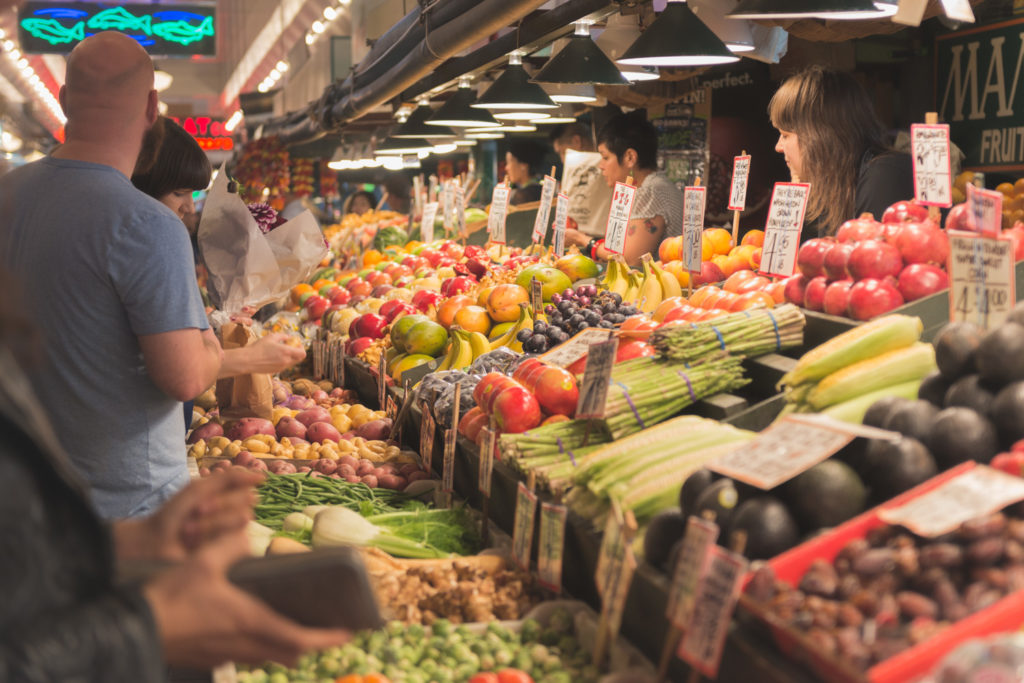
People’s foundation for physical and mental well-being starts with access to fresh air, clean water, and nutritious food. Meeting these basic needs allows us to be healthier today by avoiding hunger, exhaustion, disease, and injury. It also means we are more likely to thrive tomorrow by supporting our ability to withstand adversity.
What You Need to Know
These key issues are essential to understanding how we can support thriving people and places.
Basic Needs for Health & Safety: Food
- The higher rates of mortality in Communities of Color can be attributed, at least in part, to the greater incidence of chronic diseases— diabetes, hypertension, obesity—that are closely linked to nutrition.
- Low-income communities have limited access to affordable, nutritious food, relying instead on cheap processed foods that are high in calories but low in nutrient density.
- Although school districts nimbly met the challenge by diverting their cafeteria food programs to emergency meal delivery at pick-up locations, they did so at great sacrifice to their budgets.
- The lack of safe working conditions has left food system workers, who are 1/6 of the nation’s workforce, highly vulnerable to contracting COVID-19.
- Fifty plants produce 98% of the meat in the United States. With six multinational companies in control of global meat production, the supply chain is efficient but not resilient.
- With financial and policy support from their national and state governments, cities can lead the way toward a regionally resilient food system that supports their local as well as neighboring rural economies.
- The financial value of the long-term, high-volume contracts of schools and other large institutions is a de-risking opportunity for the supply chain, which allows for price adjustments according to that economy of mid-scale.
Historical Context
THE MID-20TH CENTURY WAS A TURNING POINT in the American food system, ushering in a precipitous decline in farm populations. With the shift toward highly consolidated, vertically integrated, and industrially efficient agriculture came a rise in obesity, a loss of agricultural biodiversity, and a rise in nitrate pollution and greenhouse gas emissions due to concentrated methods of farming and animal rearing.
Current Conditions
COVID-19 HAS HIGHLIGHTED that farmers and small businesses have precarious livelihoods that are threatened by even a short-term loss of revenue. The shutdown of the food service pipelines on which their businesses are built left many farmers and food processors dangling, imperiling their livelihoods. And yet, while the farmers and food processors were desperate to find markets for their supply, food banks were stretched beyond capacity, with not enough food to meet the dramatically sudden increase in demand.
The Good Food Purchasing Program was adopted by the City of Los Angeles and Los Angeles Unified School District in 2012. Its mission is to harness the purchasing power of large institutions to drive changes in the food supply chain. It accomplishes that goal in part through a metric-based feedback and rating tool that is used by the enrolled institutions, with the goal of supporting local economies, fair labor, environmental sustainability, animal welfare, and public health. Now a national body, the Center for Good Food Purchasing is present in 20 cities and over 45 municipal institutions.
Pivotal Moves
A Selection of Ideas for Changing Course
PIVOTAL MOVES are decisive actions that could begin now and change the course of community life relatively quickly.
LEVERAGE THE POWER OF PUBLIC CONTRACTING
Cities and counties should adopt purchasing targets for all their large food service institutions that align purchases with a commitment to local economic support, fair wages, safe working conditions, healthy people, and a healthy environment.
The targets of cities, counties, and institutions should then be aggregated into regional targets. These combined dollars can drive entrepreneurial responsiveness to community needs and make a difference in the regional food economy.
Nationally networked city procurement goals could be leveraged to influence the federal role in funding aspects of the food system.
Goals supporting local economies, sustainable production practices, fair labor practices, nutritional health, and societal equity should be targeted and implemented with equivalent priority.
COORDINATE FOR REGIONAL CHANGE
Dedicate a permanent stream of government funding for value-chain innovation among regional suppliers to create shorter, more resilient supply chains.
Promote the development of food hubs that operate as intermediaries between public institutions, neighborhood markets, community serving organizations, and local small- to mid-sized farmers and food businesses.
Use bond measures and other public finance mechanisms to fund food-focused capital projects, such as modern warehouses and logistics networks or incubator-style experimental kitchens.
Invest in the knowledge and tools to support a resilient ecosystem of food production and distribution, integrating sectors across an entire region.
ACCOUNT FOR FOOD’S TRUE COST
Begin to reverse the economic dynamics that incentivize the production of unhealthy and environmentally destructive food. This can be done by accelerating the implementation of True Cost Accounting in Food, which integrates cost-benefit analysis, life-cycle assessment, and multi-criteria analyses to capture the systemwide impact of food production.
Use the information from True Cost Accounting to set policies that address affordability by adjusting prices to reflect full societal cost (e.g., reflecting the additional cost of producing a strawberry in a manner that doesn’t harm the environment or workers).
Implement programs that match nutrition assistance benefits dollar for dollar when used for purchasing fruits or vegetables at a farmers market or similar venue.